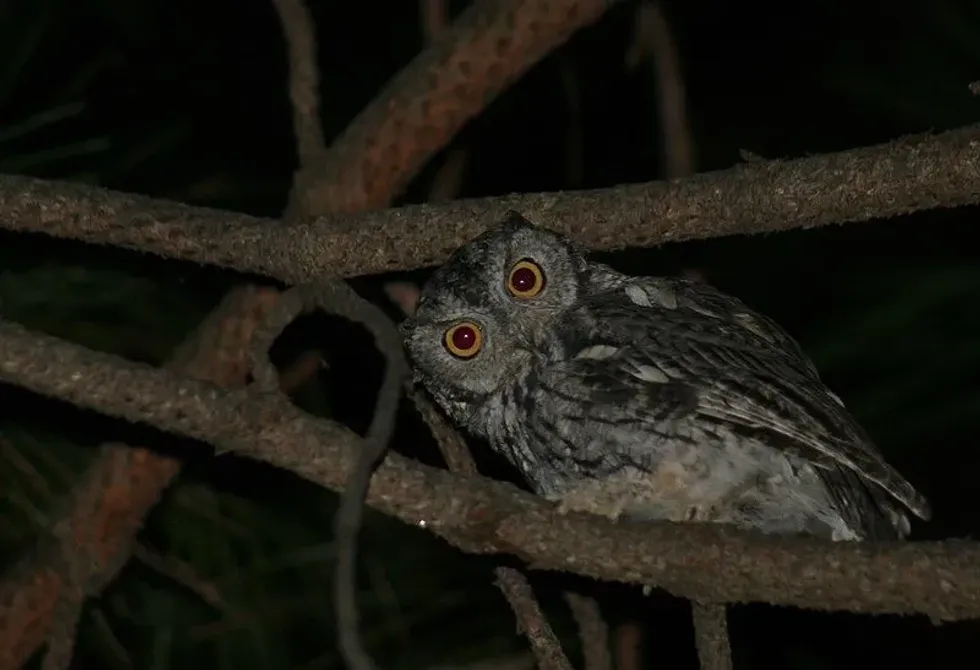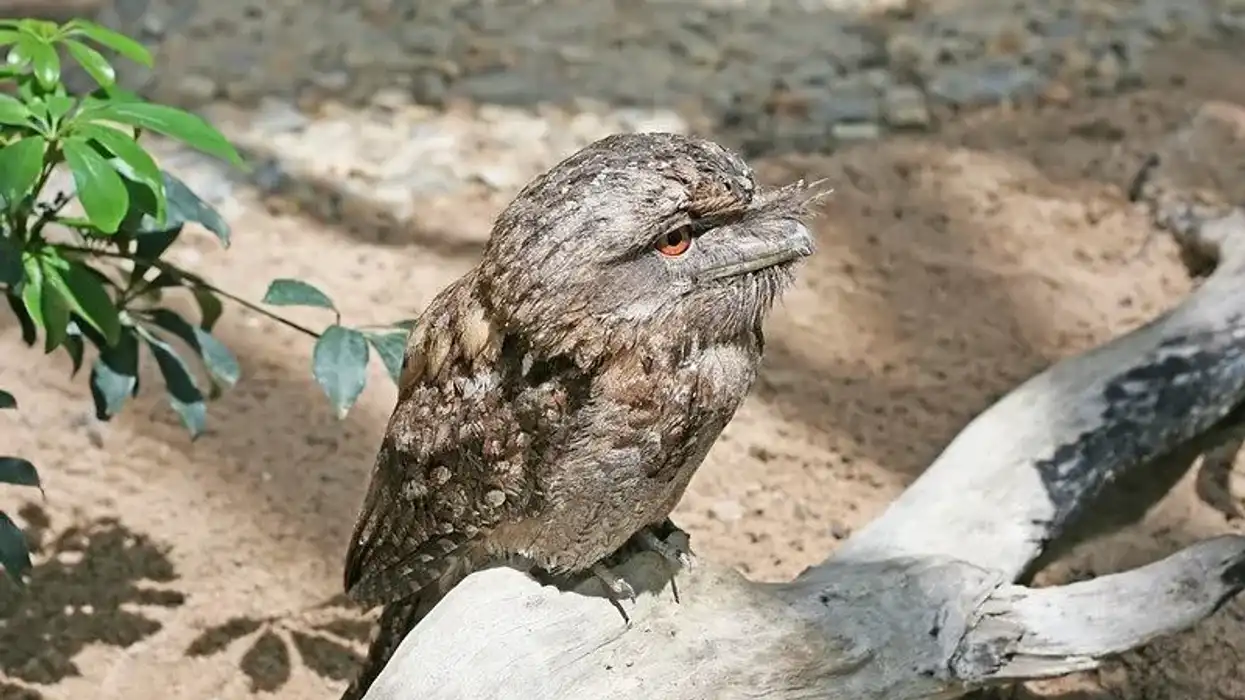The Pacific screech-owl (Megascops cooperi) belongs to the North American bird range under the genus Megascops. These birds belonging to the Strigiformes order of animals may have similar nocturnal owl habits.
They are found only in Mexico around the dry and open or semi-open arid forests and woodlands of Oaxaca, Costa Rica, and Guatemala. This species endemic to Mexico and Costa Rica is distinguished by the facial description as they have ear tufts and dark yellow or reddish-orange eyes.
This tropical bird has a medium length and may be found roosting in woodpecker nests. A Pacific screech-owl in tree hole can be almost difficult to spot due to its similarity with the bark color.
The pair is usually monogamous, and their mating occurs in the dry months around March. The females lay two to eight eggs in a large tree hole or an old woodpecker's nest.
At times, this bird's yellow beak might catch a small mammal from the rodent family as its prey. Along with these, their diet includes a lot of small birds and insects.
Read on to know more about this bird at length. For similar content, check the flammulated owl and palm cockatoo.
Pacific Screech-Owl Interesting Facts
What type of animal is a Pacific screech-owl?
Pacific screech-owls are a species of owls that belong to the Strigidae family of animals. It is a member of the Chordata phylum.
What class of animal does a Pacific screech-owl belong to?
The northwest Pacific screech-owl (Megascops cooperi) identification helps categorize them in the Aves class of animals.
How many Pacific screech owls are there in the world?
The Pacific screech-owl has a population range between 50,000 and 499,999 birds in the forest. However, their population trend has shown a decline.
Where does a Pacific screech-owl live?
This North American bird is mostly found in the regions of Mexico. Their habitat is favorable in the areas of the southern Pacific and their distribution is mainly around Costa Rica, Oaxaca, Guatemala.
What is a Pacific screech owl's habitat?
The distribution of the Pacific screech-owl (Megascops cooperi) is focused in a habitat with semi-open, tropical or subtropical, forest range. This species also lives in the woodlands and swampy areas in this natural habitat and are common in forests.
Who do Pacific screech owls live with?
This species of screech owl is solitary and mostly seen with other birds only during the mating season.
How long does a Pacific screech-owl live?
The average lifespan of all screech owls and their subspecies was recorded to reach fairly around 14 years.
How do they reproduce?
The breeding season of this species of owls is assumed to be during the dry months around March.
Although there aren't many records available related to these tropical birds' breeding, it is said that the bird pairs have brooding habits wherein the female lays two to eight eggs in trees with holes, woodpecker nests, or in a cactus. The female may be the one to incubate the eggs for 26 days.
It is common for the offspring to leave the nest and breeding range together after the fledging period passes along.
What is their conservation status?
Even though this species of the Strigidae family is only found in Mexico, Oaxaca, Costa Rica, and the southern Pacific, they are enlisted in the Least Concern category of animals by the International Union of Conservation of Nature (IUCN). They have a decreasing population trend in their distribution range.
Pacific Screech-Owl Fun Facts
What do Pacific Screech-owls look like?
The Pacific screech-owl (Megascops cooperi) are birds with ear tufts. The Pacific screech-owl orange eye or the Pacific screech-owl red eye is a distinctive feature of this species. This is because they have fairly big and round eyes that can look scary in the dark.
They have a yellow hooked beak which might be covered with a few facial whitish-brown or gray feathers. When sitting on trees, their body length may become camouflaged with their dusky brown feathers.
Their buff has dark mottling all over the body. During the flight, the Pacific screech-owl wing color looks similar to that of a moth. Their toes are similar to the yellow of their beak and eyes.
How cute are they?
Based on the physical description of these owls, you cannot consider them adorable like hummingbirds due to their dark yellow and scary eyes.
How do they communicate?
The Pacific northwest screech-owl sound is one of the reasons for their name. They communicate with screeching sounds that are common amongst these owls.
Their song is an indication of danger or any agitation. This Pacific screech-owl sound consists of a maximum of 15 short notes put together with 'prrr-pu-pu' in the Ridgway, 1878 species of Otus cooperi or the other sound 'grrrrrr-go-goo' used by its subspecies named the M.c. Lambi.
How big is a Pacific screech-owl?
The Pacific screech-owl back might look more petite. They are medium-sized owls with a length range of 8.7-10.2 in (22-26 cm). These species belonging to the Strigiformes order of animals are almost the same size as an average great grey owl.
How fast can a Pacific screech-owl fly?
Even though the sight of this Pacific screech-owl flying is relatively uncommon, it is known that they fly with short yet rapid wing movements. This is measured with their five strokes of wings per second.
How much does a Pacific screech-owl weigh?
These owls of the Strigidae family are medium-sized ones with a weight range of 4.1-6.2 oz (115-175g). A barn owl is bulkier than them.
What are the male and female names of the species?
The Pacific screech-owl (Megascops cooperi) is a gender-neutral name used for both male and female birds.
What would you call a baby Pacific screech-owl?
Pacific screech-owl babies are called nestlings or owlets.
What do they eat?
This species of screech-owls has a carnivorous diet. The central part of their diet includes all anthropods, small mammals like squirrels, insects, and small vertebrates like birds. However, it is not known if they eat rodents like gophers.
Are they dangerous?
Even though there aren't many records of these owls harming humans, this bird is considered aggressive. The bird may become aggressive if anyone trespasses in its nesting range and might hover around like bats to distract or attack predators of any kind.
Would they make a good pet?
You might find the Pacific screech-owl scary due to its physical description and large eyes, a reason for humans not to keep it as a pet. Also, as this species loves spending their time in the wild, keeping them in captivity is not advisable.
Did you know...
Even though this dark and mysterious-looking species is solitary, they are seen in groups, especially during mating. These groups of the owls in its range of Mexico, Costa Rica, and Oaxaca are called a bazaar, parliament, or even wisdom by people.
Even though they are called screech-owl, their song or call is primarily a voice focused with short trills more than the similar-sounding screeches.
Do Pacific screech-owls sleep during the day?
This species is slightly nocturnal but not diurnal, which means they are usually active in the dark at night and do not roam around during the day. They are known to roost during the daytime for sure, although they are active during dusk or in the dark.
How many eggs does a Pacific screech-owl lay?
The owls related to this species may lay around two to eight eggs in one breeding cycle. The eggs of this Megascops genus are of natural white and not too large.
Here at Kidadl, we have carefully created lots of interesting family-friendly animal facts for everyone to discover! Learn more about some other birds from our rufous owl facts and burrowing owl facts for kids.
You can even occupy yourself at home by coloring in one of our free printable owl coloring pages.
Second image by Chris Jimenez from CR









